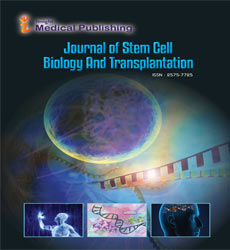MSCs) and an antioxidant such as silymarin have been
postulated as hepatoprotectors against ionizing radiation
induced injury. The present study was undertaken to evaluate
the protective effect of MSCs and silymarin to ameliorate
damage caused by gamma radiation. Bratton-Marshall Reagent
was given by intravenous injection to male rats, one day post
gamma irradiation at the dose level of 4 Gy. Rats were orally
administrated silymarin at dose (70 mg/kg dissolved in distilled
water) before irradiated three days and continued for 21 days
post irradiation. After one and three weeks post irradiation
results revealed that irradiated animals receiving MSCs and
silymarin separately or with each other exhibited a pronounced
elevation in liver antioxidant such as glutathione (GSH)
superoxide dismutase (SOD), glutathione-S-transferase (GST),
total antioxidant capacity (TAC), catalase (CAT) and glucose-6-
phosphate dehydrogenase (G-6-PDase) activity accompanied
with significant decline in lipid peroxidation and hydrogen
peroxide levels in comparing with irradiated rats. Moreover,
RAPD-PCR with primers OP-B10 and OP-B14 exhibited different
banding patterns in all treated rats compared to untreated
control rats after one and three weeks of treatment. In
conclusion, treatment with MSCs and silymarin possess a radio
protective capacity against ionizing-radiation induced oxidative
stress and organ injury. In multicellular organisms, stem
cells are
undifferentiated or partially differentiated
cells that can
differentiate into various types of
cells and proliferate
indefinitely to produce more of the same stem cell. They are the
earliest type of cell in a cell lineage.
Embryonic
Embryonic stem
cells (ESCs) are the
cells of the inner cell mass
of a blastocyst, formed prior to implantation in the uterus. In
human embryonic development the blastocyst stage is reached
4â??5 days after fertilization, at which time it consists of 50â??150
cells. ESCs are pluripotent and give rise during development to
all derivatives of the three germ layers: ectoderm, endoderm
and mesoderm. In other words, they can develop into each of
the more than 200 cell types of the adult body when given
sufficient and necessary stimulation for a specific cell type. They
do not contribute to the extra embryonic membranes or to the
placenta. During embryonic development the
cells of the inner
cell mass continuously divide and become more specialized. For
example, a portion of the ectoderm in the dorsal part of the
embryo specializes as 'neurectoderm', which will become the
future central nervous system. Later in development,
neurulation causes the neurectoderm to form the neural tube.
At the neural tube stage, the anterior portion undergoes
encephalization to generate or 'pattern' the basic form of the
brain. At this stage of development, the principal cell type of the
CNS is considered a neural stem cell. The neural stem
cells selfrenew and at some point transition into radial glial progenitor
cells (RGPs). Early-formed RGPs self-renew by symmetrical
division to form a reservoir group of progenitor cells. These cells
transition to a neurogenic state and start to divide
asymmetrically to produce a large diversity of many different
neuron types, each with unique gene expression, morphological,
and functional characteristics. The process of generating
neurons from radial glial
cells is called neurogenesis. The radial
glial cell, has a distinctive bipolar morphology with highly
elongated processes spanning the thickness of the neural tube
wall. It shares some glial characteristics, most notably the
expression of glial fibrillary acidic protein (GFAP). The radial glial
cell is the primary neural stem cell of the developing vertebrate
CNS, and its cell body resides in the ventricular zone, adjacent to
the developing ventricular system. Neural stem
cells are
committed to the neuronal lineages (neurons, astrocytes, and
oligodendrocytes), and thus their potency is restricted.
Therapeutic effect of mesenchymal stem cells transplantation (MSCs) and an antioxidant such as silymarin have been postulated as hepatoprotectors against ionizing radiation induced injury. The present study was undertaken to evaluate the protective effect of MSCs and silymarin to ameliorate damage caused by gamma radiation. Bratton-Marshall Reagent was given by intravenous injection to male rats, one day post gamma irradiation at the dose level of 4 Gy. Rats were orally administrated silymarin at dose (70 mg/kg dissolved in distilled water) before irradiated three days and continued for 21 days post irradiation. After one and three weeks post irradiation results revealed that irradiated animals receiving MSCs and silymarin separately or with each other exhibited a pronounced elevation in liver antioxidant such as glutathione (GSH) superoxide dismutase (SOD), glutathione-S-transferase (GST), total antioxidant capacity (TAC), catalase (CAT) and glucose-6- phosphate dehydrogenase (G-6-PDase) activity accompanied with significant decline in lipid peroxidation and hydrogen peroxide levels in comparing with irradiated rats. Moreover, RAPD-PCR with primers OP-B10 and OP-B14 exhibited different banding patterns in all treated rats compared to untreated control rats after one and three weeks of treatment. In conclusion, treatment with MSCs and silymarin possess a radio protective capacity against ionizing-radiation induced oxidative stress and organ injury. In multicellular organisms, stem cells are undifferentiated or partially differentiated cells that can differentiate into various types of cells and proliferate indefinitely to produce more of the same stem cell. They are the earliest type of cell in a cell lineage.
